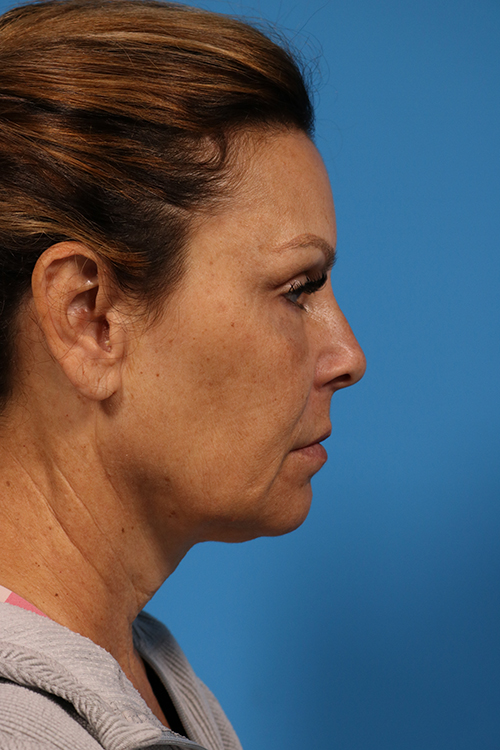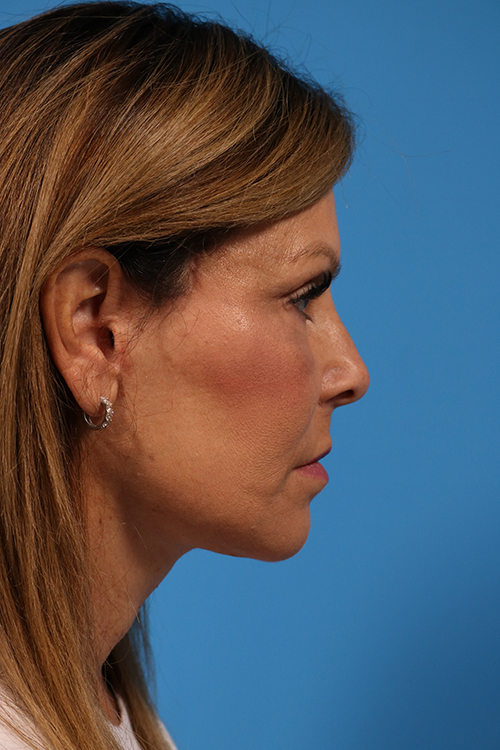Deep Plane Facelift
Almost everyone has heard of a facelift, but you may not be familiar with a deep plane facelift. This technique, while not new, can offer superior and longer-lasting results in some instances. A traditional facelift technique may be more appropriate for some patients, but a deep plane facelift presents an alternative in many cases.
Let’s take a look at a Newport Beach traditional facelift versus a deep plane facelift.
What Is a Deep Plane Facelift?
Your facial appearance is not only the result of your skin but also the underlying tissue. This tissue includes facial fat, muscles, connective tissue like fascia and ligaments, and the bone structure of your skull.
A traditional facelift is also known as a SMAS (superficial muscular aponeurotic system) facelift. The SMAS is a fibrous system that connects the muscles underlying the face to the dermis or deeper layer of the skin. A surgeon can tighten the facial skin and give their patient a younger appearance by accessing this plane.
In many cases, a SMAS facelift is sufficient. This type of facelift can reduce or eliminate wrinkles, sagging skin, and other signs of aging. However, sometimes a deeper approach is necessary.
As the name implies, a deep plane facelift uses a deeper plane than a SMAS facelift. Although the deep plane facelift is a newer technique than a SMAS facelift, surgeons have been using this procedure for over 30 years. In a deep plane facelift, Dr. Batniji can manipulate the ligaments that retain the facial muscles. This technique allows for the maximum mobilization of facial features and permits closure without tension. So, even though a deep plane facelift uses a plane below the SMAS, it can be less traumatic for the patient than a traditional facelift or mid-facelift.
It is important to understand that a deep plane facelift is not a mini facelift. These are two very different procedures. A deep plane facelift can produce dramatic, long-lasting results that are, in some cases, even more pronounced than from a traditional facelift.
Who Is an Ideal Candidate for a Deep Plane Facelift?
In general, deep plane facelifts are well-suited for people in their 50s and older. This is not to say that patients in their 30s or 40s cannot have a deep plane facelift, but the procedure tends to produce better results for older individuals.
Also, if you’ve had a previous SMAS facelift and want to extend or improve your results, a deep plane facelift may be an excellent choice. Because it uses a different tissue plane than the SMAS, previous facelift patients can usually choose the deep plane approach for a repeat facelift.
Of course, you should always let your surgeon know if you have any medical conditions, take any medications, or are pregnant. In addition, if you smoke, you should stop before pursuing a facelift procedure. Some studies estimate that smokers are up to 14 times more likely to encounter facelift complications than non-smokers.
Finally, your aesthetic goals may influence the type of facelift procedure you select. A deep plane facelift may be more appropriate if you have concerns about jowls around the lower cheeks and chin. Additionally, a deep plane facelift may be a good choice if you have crow’s feet or other undesired features around your eyes.
Don’t worry too much about which procedure you want when considering a facelift. Dr. Batniji and his team are happy to guide you through the process, set realistic expectations, and help you make an informed and suitable decision. They have many decades of experience and will be with you every step of the way.
What Should You Expect with a Deep Plan Facelift?
In the video below, Dr. Batniji explains his approach to the deep plane facelift:
The process begins by contacting Dr. Batniji and scheduling a consultation. He will listen to your concerns, explain the procedure, and answer any questions you may have. Keep in mind that your facelift can be performed alone or in combination with other procedures such as eyelid surgery or a brow lift.
While a facelift is an outpatient procedure, we offer a complimentary overnight stay at the surgery center where our patients are cared for by 2 nurses. A board certified anesthesiologist provides the appropriate level of anesthesia for you and your procedure and monitors you throughout the procedure. Your facial plastic surgery will likely be performed under sedation with a local anesthetic. In some cases, general anesthesia is used.
The surgical incisions are hidden next to your ears, avoiding any obvious scars. Dr. Batniji will lift the facial skin and connective tissue and remove any excess skin. Once the facial lifting is complete, he will close the incisions with sutures. Although the process may sound simple, it takes years of experience, training, and natural skill to produce excellent cosmetic results from a deep plane facelift.
The recovery process varies from patient to patient, but it generally takes two to three weeks to get “through the woods” of a deep plane facelift recovery. Your face will be bandaged at first, and you likely will not be able to open your mouth very wide. You will receive medication for pain if needed, and facial soreness will set in after the first postoperative day or so.
You will notice facial swelling and bruising in the first week after surgery. These issues will gradually resolve. By the end of week three, most patients feel much better and are ready to see friends again.
Why Choose Dr. Batniji for a Deep Plane Facelift?
When selecting a plastic surgeon for your deep plane facelift, you’ll want an expert who specializes in facial plastic surgery. Many plastic or cosmetic surgeons do it all—tummy tucks, liposuction, butt lifts, etc. This is not the case with Dr. Batniji. He focuses solely on the face and devotes himself to this technically challenging region of the human body.
Dr. Batniji also possesses many years of education, training, and experience. He is board-certified by the American Board of Facial Plastic and Reconstructive Surgery. He is also recognized as an expert by his peers and is a celebrated international lecturer on facial plastic and reconstructive surgery topics.
Most importantly, Dr. Batniji has genuine compassion and concern for his patients. You can be assured that he will give your case his utmost devotion and provide outstanding surgical care. Fill out a form below to schedule a consultation today!
Recovering from a Deep Plane Facelift: Timelines and Limitations
The recovery process after a deep plane facelift is an important part of the overall procedure and unique to each individual, but the average recovery time is around 10 to 20 days. It is during this time that the body will heal, swelling and bruising will subside, and the final results of the procedure will become visible.
After surgery, dressings will be removed the day following the procedure and sutures will be removed in stages from day 5 to day 10-12. Generally, patients can begin applying makeup to their incision sites around 14 days after surgery, but it’s important to note that the healing process continues for several months.
It is common to experience swelling and bruising after an extended deep plane facelift, but by 10 to 14 days post-surgery, you can expect these side effects to significantly improve. Over the following days and weeks, you can anticipate additional improvement as swelling and bruising continues to subside.
Timeline:
- Swelling and bruising are common in the neck region 2-3 days after surgery but should start to subside after that time.
- Patients should expect to keep their head elevated for the first week of recovery and to avoid bending, straining, or lifting anything during that time.
- Sutures and staples will be removed one week after surgery.
- A neck wrap will be worn at all times for one week after the procedure and may be worn at night for an additional 2-3 weeks as instructed by Dr. Batniji.
Limitations:
- Patients should not take aspirin or ibuprofen products, as they may increase the risk of bleeding.
- Patients should avoid turning their head from side to side and instead turn with their whole upper body.
- Pain medication should be weaned off of as soon as possible, with Tylenol used in place of the narcotic medication.
- Patients should not take narcotic medication on an empty stomach to avoid feeling nauseous.
Post-Operative Instructions:
- Clean all suture lines 4 times daily with hydrogen peroxide on a Q-tip, then apply a thin layer of Vaseline or Bacitracin antibiotic ointment.
- Use cold compresses (washcloths soaked in ice water) for the first 24-48 hours to minimize swelling.
- Shower at least once a day and shampoo hair with baby shampoo only.
- Keep head elevated and replace wrap dressing as necessary.
- Watch for any abnormal swelling in the neck region and contact Dr. Batniji if necessary.
Following these post-operative instructions and keeping the timeline and limitations in mind will help ensure a successful and comfortable recovery from your deep plane facelift procedure.



